 The geology of Diamonds consist of crystalline carbon although a significant proportion of diamonds are derived from placid deposits i.e. hosted in sediments, placid’s are secondary deposits and all diamonds were at one time or another hosted by kimberlite igneous rocks. The name Kimberlite comes from the town of Kimberley which grew up around the prolific diamond mines in northern South Africa. This is where Cecil Rhodes established to be as consolidated mines in 1888 named after the local farmer whose land the discovery was made on and you can see one of the old abandoned pits in the picture bottom right. The upper portion of the pit was dug by hand in the 1880s that’s where the photo in the top right was taken. Kimberlite most commonly form pipe shaped intrusives often fairly small in diameter but they may also form dykes or even beds of volcanic plastics surrounding the intruded pipes. Kimberlite is basically a form of peridotite in other words composed dominantly of olivine, a particular type of chrome rich granite and you’ll see why this is important when we come to talk about diamond exploration. Fresh kimberlite is hard and a dark blue green color and as it oxidizes it becomes much softer and changes to a yellow brown. The change from oxidized to fresh kimberlite occurs at the breaker slopes in the photo of the old pit in the bottom right.
The geology of Diamonds consist of crystalline carbon although a significant proportion of diamonds are derived from placid deposits i.e. hosted in sediments, placid’s are secondary deposits and all diamonds were at one time or another hosted by kimberlite igneous rocks. The name Kimberlite comes from the town of Kimberley which grew up around the prolific diamond mines in northern South Africa. This is where Cecil Rhodes established to be as consolidated mines in 1888 named after the local farmer whose land the discovery was made on and you can see one of the old abandoned pits in the picture bottom right. The upper portion of the pit was dug by hand in the 1880s that’s where the photo in the top right was taken. Kimberlite most commonly form pipe shaped intrusives often fairly small in diameter but they may also form dykes or even beds of volcanic plastics surrounding the intruded pipes. Kimberlite is basically a form of peridotite in other words composed dominantly of olivine, a particular type of chrome rich granite and you’ll see why this is important when we come to talk about diamond exploration. Fresh kimberlite is hard and a dark blue green color and as it oxidizes it becomes much softer and changes to a yellow brown. The change from oxidized to fresh kimberlite occurs at the breaker slopes in the photo of the old pit in the bottom right.

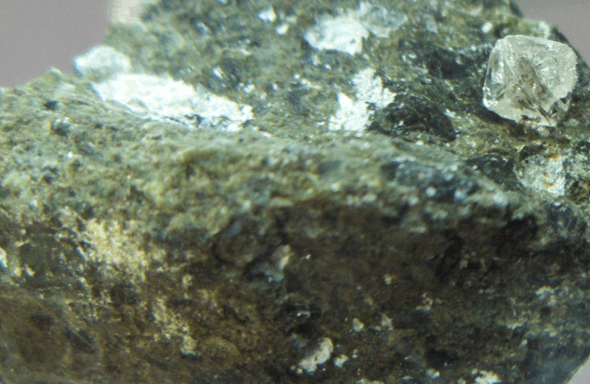 |
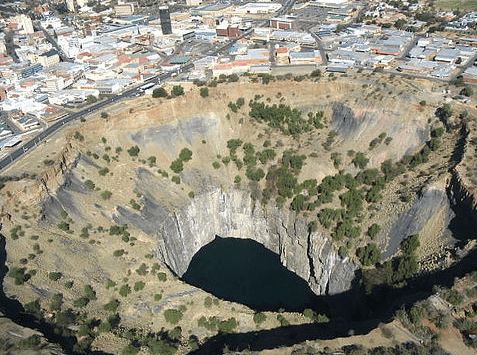 |
Now I emphasized in that first introductory Exploration Geology Course how all the materials we mine are derived from the crust and that’s fundamentally correct however although diamonds are mined from the crust they have their origins in the mantle, more than 100 km below the base of the crust. Most of the kimberlite melt is derived from even deeper in the mantle and the diamonds are picked up by the melt on its way to the surface and that’s why I’ve included kimberlites early in this series of Exploration Geology Courses rather than lumping them with the shallow epithermal processes.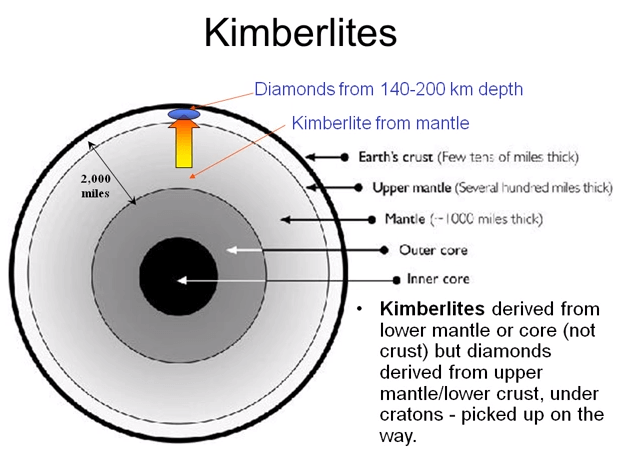
The earth is about 4.5 billion years old and although the kimberlites were introduce between 2 billion years ago and the present some diamonds started crystallizing out more than 3 billion years ago just 25% into the life of the earth. They then floated around for millions of years in the plastic crystal mush waiting for their ride up to the surface. Diamonds are only formed under continental plates where the correct temperature and pressure conditions exist not under any oceanic plates and because they formed earlier in history they generally only under old archean crust a critical point when we come to diamond exploration.
 Kimberlites must be in placed fast in order to avoid the diamonds being re-absorbed or re-melted as the pressure drops. As kimberlites rise the degas large amounts of high-pressure carbon dioxide, when they get close to the surveys that gas expands and they mix with groundwater develop a fluidize almost foamy consistency that causes them to complete their journey to the surface with explosive force. There the kimberlite erupts violently but briefly forming a crater and blowing fragments of kimberlite into the air and the craters are often partially filled with mixture of ejected kimberlite fragments and wall rock that falls back to surface.
Kimberlites must be in placed fast in order to avoid the diamonds being re-absorbed or re-melted as the pressure drops. As kimberlites rise the degas large amounts of high-pressure carbon dioxide, when they get close to the surveys that gas expands and they mix with groundwater develop a fluidize almost foamy consistency that causes them to complete their journey to the surface with explosive force. There the kimberlite erupts violently but briefly forming a crater and blowing fragments of kimberlite into the air and the craters are often partially filled with mixture of ejected kimberlite fragments and wall rock that falls back to surface.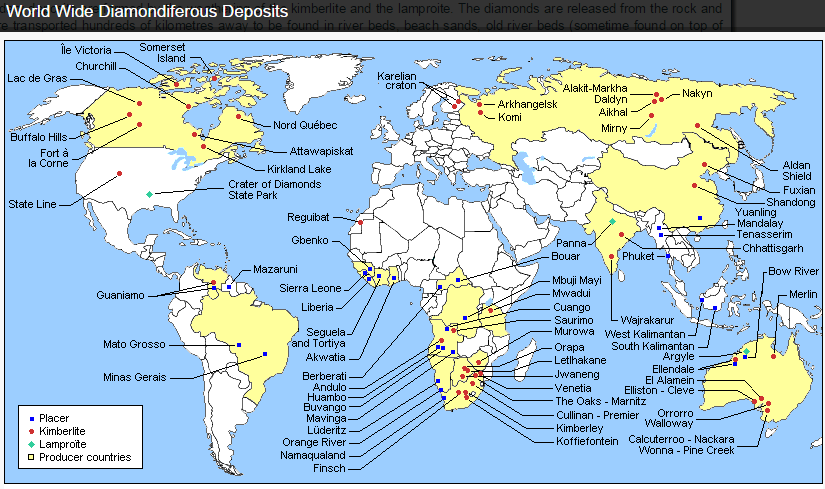
As I mentioned earlier although there are kimberlites in a variety of geological terrains, diamondiferous pipes are almost always in or above archean cratons and those are the orange areas on the map and only a few of those kimberlite types that are on archean crust actually contain diamonds and even fewer of those diamondiferous pipes contain enough diamonds to make economically viable. In fact only about 1% of kimberlite pipes host economic diamonds.
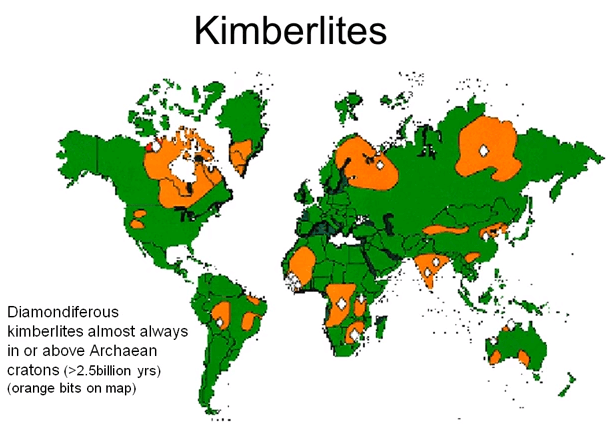
Something like 80% of the world diamond production comes either from Sub-Sahara in Africa or Russia. In Africa the big producers are Botswana, South Africa, Congo DRC, Angola and Namibia. Zimbabwe’s production has ballooned in the last two or three years with the discovery of the merengue deposit but since it was discovered by Mugabe and confiscated by Mugabe and his inner circle no production figures are available. Diamond grades of economic kimberlites vary hugely.
- The premier deposit in South Africa as a phenomenal grade of almost 34,000 carats per hundred tons of ore.
- In Botswana in Orapa it has a grade of about 120 carats per hundred tons.
- Jwaneng also in Botswana 44 carats per hundred tons and Letseng in Lesotho a mere 2 carats per hundred tons.
So you might ask how Letseng survives economically with a pitiful grade of only 115,000th of premier’s grade. The answer lies in the stone size and quality. Letseng hosts some of the biggest diamonds ever discovered. The photo shows an exact replica of two of these mammoth stones. In diamonds the size and the quality of the stones is more important than the overall grade in terms of carats per hundred tons. This is an exception to the grade is king saying that you so often hear among minors.

How do we explore for diamonds:
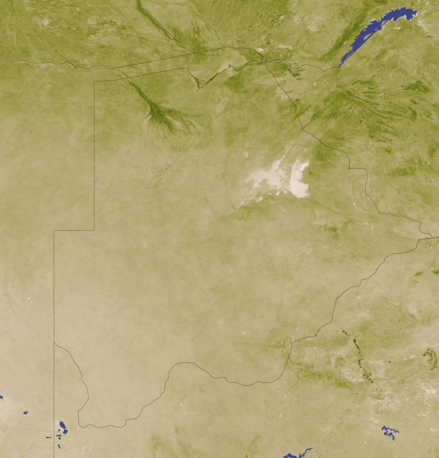 We start with the knowledge that diamonds are first kimberlites and exist only above archean cratons and that they tend to form clusters within broad linear trends. The main exploration tools are geophysical surveys. Kimberlites contain magnetite and have a relatively high specific gravity so either magnetic or gravity surveys can be used so as long as the rock into which the kimberlites are being emplaced have low gravity or magnetic characteristics. The picture in this slide in the top right is a satellite image of the featured Kalahari desert in Southern Botswana roughly circular features are shallow sulk pans unrelated to kimberlites. Bedrock and kimberlites are masked by tens of meters of wind-blown sand but when you put a magnetic image over the same area you can clearly see the kimberlite pipes hidden below that sand cover. Ground prospecting relies on what’s called KIMS or Kimberlite Indicator Minerals. You’ll remember I mention the chromite rich garners that are often found in kimberlites. These are almost unique to kimberlites other accessory minerals include chromite, ilmenite, clinopyroxenes and obviously olivines all of these have higher densities than say quarts or feldspar and they are classified as kimberlite indicator minerals. KIM sampling involves taking wide space soil or stream sediment samples separating out the heavy minerals and examining them under a binocular microscope to look for the presence of KIMS. If kimberlite is founded out crop taking small bulk sample at surface may be possible.
We start with the knowledge that diamonds are first kimberlites and exist only above archean cratons and that they tend to form clusters within broad linear trends. The main exploration tools are geophysical surveys. Kimberlites contain magnetite and have a relatively high specific gravity so either magnetic or gravity surveys can be used so as long as the rock into which the kimberlites are being emplaced have low gravity or magnetic characteristics. The picture in this slide in the top right is a satellite image of the featured Kalahari desert in Southern Botswana roughly circular features are shallow sulk pans unrelated to kimberlites. Bedrock and kimberlites are masked by tens of meters of wind-blown sand but when you put a magnetic image over the same area you can clearly see the kimberlite pipes hidden below that sand cover. Ground prospecting relies on what’s called KIMS or Kimberlite Indicator Minerals. You’ll remember I mention the chromite rich garners that are often found in kimberlites. These are almost unique to kimberlites other accessory minerals include chromite, ilmenite, clinopyroxenes and obviously olivines all of these have higher densities than say quarts or feldspar and they are classified as kimberlite indicator minerals. KIM sampling involves taking wide space soil or stream sediment samples separating out the heavy minerals and examining them under a binocular microscope to look for the presence of KIMS. If kimberlite is founded out crop taking small bulk sample at surface may be possible.  Assaying the sample and plotting the calcium against chromium content on a graph like this allows you to differentiate potentially diamondiferous kimberlites, left at the red line from barren kimberlites to the right of the red line however as with most deposits confirmation of these indirect exploration methods required drilling and testing for diamonds. Diamond exploration is one of the riskiest exploration ventures. The odds are strongly stacked against success however with good science and exploration techniques that level of risk that can be considerably reduced and the rewards when successful are enormous. Just look at the sale prices for some of these high-quality stones bottom left set 4.6 million center $10.4 million $12.36 million all for individuals stones very, very profitable.
Assaying the sample and plotting the calcium against chromium content on a graph like this allows you to differentiate potentially diamondiferous kimberlites, left at the red line from barren kimberlites to the right of the red line however as with most deposits confirmation of these indirect exploration methods required drilling and testing for diamonds. Diamond exploration is one of the riskiest exploration ventures. The odds are strongly stacked against success however with good science and exploration techniques that level of risk that can be considerably reduced and the rewards when successful are enormous. Just look at the sale prices for some of these high-quality stones bottom left set 4.6 million center $10.4 million $12.36 million all for individuals stones very, very profitable.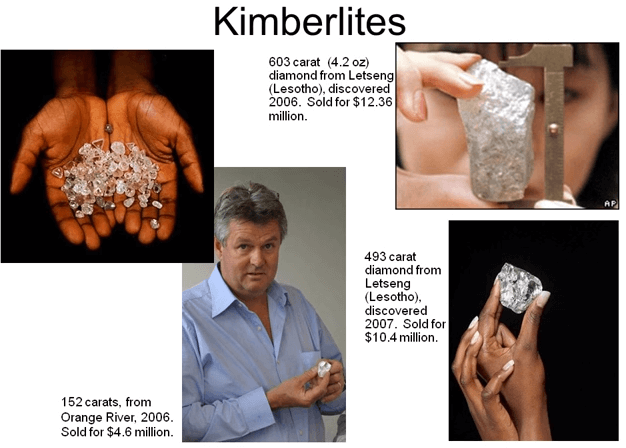
What have you learnt on diamonds and kimberlites: Firstly all diamonds originate in kimberlite pipes or dykes including those in placid deposits. Kimberlite is an ultramafic rock derived from the mantle. Diamonds crystallize in the mantle well below the crust but they are carried up into the crust by the rising kimberlitic magma. Only 1% of kimberlite is economic and these are almost always found in or above Archean cratons. Sub-Sahara in Africa and Russia together produce 80% of the world’s diamonds. Diamond exploration relies heavily on magnetic and gravity surveys and sampling for kimberlite indicator minerals or KIM and the value of the deposit is more dependent on the quality of the stones than on the grade in terms of carats per hundred tons.
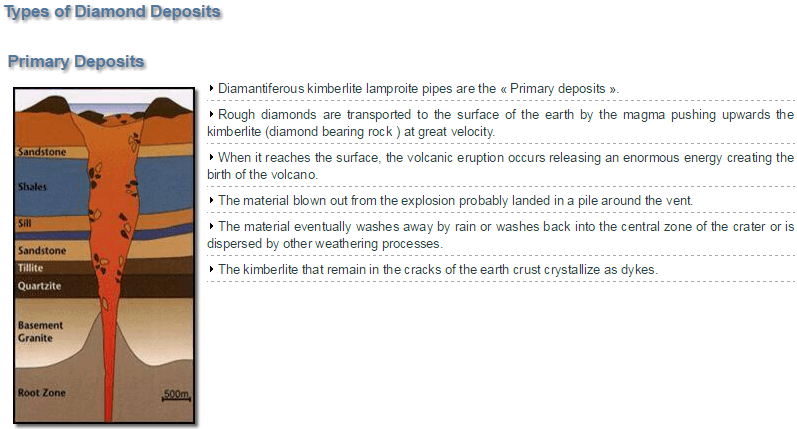
Avoid passing kimberlite into any Jaw Crusher.
